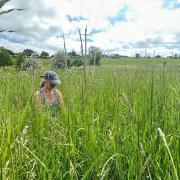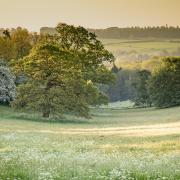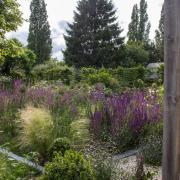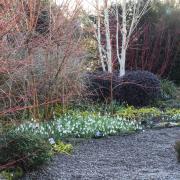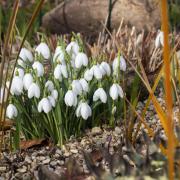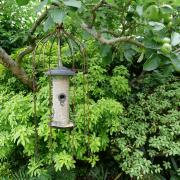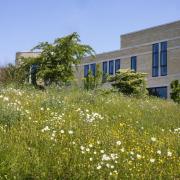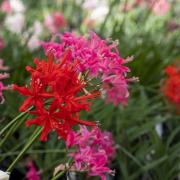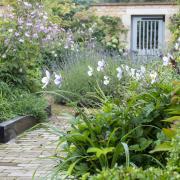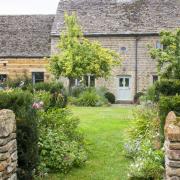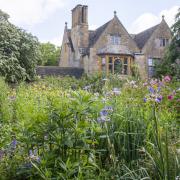Highgrove is one of the country’s most famous gardens. Mandy Bradshaw takes a tour

It’s probably treasonable but when I first visited Highgrove some 12 years ago I was distinctly underwhelmed. Admittedly there were areas of interest but the garden seemed a mish-mash of styles, a prime example of too many fingers in the horticultural pie.
So, on a recent return visit, I was surprised to find myself warming to it. Highgrove has matured into itself and subtle changes have softened the edges in what is one of the most varied gardens I’ve encountered.
The Sundial Garden is no longer a stark black and white themed space – cutting off the deep red flowers of Dahlia ‘Bishop of Llandaff to leave just the dark foliage had struck me as bizarre – and is now a far more restful mix of blues, mauves and pinks that fit sympathetically with the Georgian house. An infestation of box blight has necessitated a rethink in the Box Topiary Garden but the perennials and Mediterranean shrubs that have replaced the box blend more naturally with the cottage gardens beyond.
Meanwhile, the Stumpery has grown to fill out the gaps between the twisted tree roots and has lost the just-planted manmade feel while the Thyme Walk, which I remembered as one of the highlights, seemed even more dazzling – helped possibly by the fact that the yew had yet to be clipped and was in its full golden glory.
In the past, Highgrove was a garden of limited and sometimes difficult access with pre-booked groups only and a waiting list of some years. Today, while security is of necessity still tight – identities are carefully checked, routes are strictly adhered to and there is no opportunity for free-range wandering – visitors can book individually and be put into guided tours. From just a few thousand visitors a year, Highgrove has grown into a money-making business with on average 37,000 visitors annually. All the money raised through the two-hour tours and the busy shop and restaurant at the garden go to the Prince’s Charitable Foundation.
It is naturally popular; garden gate gazing is a national pastime and when the garden belongs to the heir to the throne the interest is even stronger. Yet, despite 12 tours a day, Highgrove never feels crowded. True you may cross paths with another group but the layout of the 16 acres means the parties of no more than 26 are easily absorbed.

In the introductory video shown to tours before they start, the Prince says Highgrove is not one garden but “a linked series unique in its planting, structure and character.” These areas have been created with the help of some of the country’s leading gardeners: Sir Roy Strong, Isabel and Julian Bannerman, Lady Salisbury and Rosemary Verey. Yet all are based on the Prince’s own ideas and it is his interests that inform the garden.
Underpinning the whole enterprise is his wholehearted belief in the need to garden organically and sustainably. From the start, visitors are left in no doubt that this is a garden that uses no chemicals or artificial fertilisers; “Be aware you are now entering a specially decontaminated zone” declares a notice at the entrance.
In addition to following only organic methods of dealing with pests and diseases, Highgrove has a reed bed sewage system, a huge composting area and even cleverly hidden water butts in the Sundial Garden that collect bath water from the house.
The gardens divide roughly into two styles: the type seen, albeit on a smaller scale, in plots across the country and the more idiosyncratic.
Among the familiar ideas are the cottage gardens, the first designed by the late Rosemary Verey, and the second a later addition. These are areas of wide, meandering paths, traditional planting – opium poppies, salvia, rosemary and the Prince’s favourite delphiniums. Alchemilla mollis is allowed to self-seed into gaps in the paving, Geranium psilostemon scrambles over borders and a summerhouse, designed by Mark Hoare, is a rustic centrepiece.
The rose pergola is another traditional feature of many English gardens. Made of Cotswold stone, English oak and stainless steel it is given a contemporary twist with clipped rounds of box at the foot of each pillar while the whole thing frames a long vista across the garden.

Possibly the best known vista is that of the Thyme Walk, which is flanked by golden yew. One of the few original features of the garden, these have been clipped into a range of fantastic shapes. The Thyme Walk, numbering more than 20 different varieties, runs from the Terrace Garden near the house, a scented secluded area of cistus, box, sage and ancient olives set around a millstone water feature, down to the Lily Pool Garden. Here, Mediterranean-style planting with a yellow and mauve theme complements huge Spanish sherry pots set in each corner.
This strong central line is emphasised by a stilted hornbeam hedge that runs on two sides of the Thyme Walk and the topiary yew hedge that surrounds the main lawn. Beautifully clipped into a series of swooping curves, cones and balls, it takes around three weeks to cut.
Yew is also used to enclose the Sundial Garden, named after a gift from the late Duke of Beaufort. Box hedges with yew corners enclose a mix of lilies, delphiniums, white Lupinus ‘Polar Princess’, geraniums, purple campanula, sweet Williams and roses. The high yew hedge has ‘windows’ cut into it, allowing glimpses of the garden beyond, while large wrought iron gates, found at a reclamation yard, were restyled by the Bannermans to incorporate the Prince of Wales’ feathers and now frame the view over the Wild Flower Meadow.
The meadow is one of Highgrove’s triumphs. The four-and-a-half acres are arguably at their best in late spring when a blue haze descends from alliums and camassias. The area is managed as a traditional hay meadow, cut by scythes and then grazed by sheep, and includes scabious, ox-eyed daisies, knapweed, poppies and three different types of orchid. At one end are some of the Prince’s National Collection of beech while a fastigiate hornbeam avenue divides the meadow and links the formal gardens around the house with the Kitchen Garden.
When the Prince bought Highgrove in 1980, this was a run-down area used for potatoes and pigs. Bulldozers were brought in to clear the site and it was laid out in the shape of the crosses of St George and St Andrew using box hedges. Due to blight those hedges have now been replaced with teucrium, which has the added advantage of flowers in mid-summer. Further structure comes from fruit trees, trained as an arch over the central path, and long tunnels of sweet peas in the summer.
At the heart of the garden is a fish-stocked pool with a wonderfully calcified fountain at the centre and Rosa ‘Raubritter’ tumbling gently down towards the water.

Pretty as well as productive, the Kitchen Garden grows a full range of organic fruit and vegetables and has long herbaceous borders planted in a mix of blue, mauve and pink with geranium, delphinium, lilies, salvias and astrantia. The produce is used in the house and restaurant with surplus finding its way into products sold in the Highgrove shop.
If all this is familiar in most large English gardens, the nearby Winterbourne Garden is more unusual. A sheltered part, it was used for a collection of tree ferns given to the Prince. Several cold winters have resulted in some casualties and replanting features hydrangea, philadelphus, flowering cornus and ceanothus while the trunks of the dead tree ferns are now used to edge the paths.
The Stumpery is another less commonly seen feature. Ferns, brunnera and the Prince’s National Collection of large and giant leaved hostas grow among the twisted roots of mainly chestnut. A stone water feature has a crown of gunnera and water falling into clam shells from Sandringham. Nearby is a Japanese Moss Garden presided over by a statue of Isis, the Egyptian Goddess of Nature.
More unusual still is the Carpet Garden, created for the 2001 Chelsea Flower Show and based upon a Turkish-style carpet at Highgrove. It is perhaps no accident that this area is walled off from the rest of the garden as it represents an abrupt change in style. There’s a rich mix of purple and pink: dark berberis used as low hedges, cerise pelargoniums, soft pink roses, vibrant fuchsias and pink centranthus. Water spills from a central fountain surrounded by ceramic tiles and in summer the air is filled with the scent of citrus and mock orange.
Throughout the garden there are reminders that this is a family space. The Temple of Worthies in The Stumpery has a bronze relief of the Queen Mother; gates leading from The Orchard are now named the Shand Indian Gates in memory of the Duchess of Cornwall’s brother, while a thatched tree house, known as ‘Hollyrood House’ after the holly that used to support it, was once used by the young William and Harry. In the arboretum stands The Sanctuary used by the Prince as a private place of contemplation while the Azalea Walk has a memorial to his much-loved Jack Russell Tigga.
Gifts to the Prince have been cleverly incorporated. Pieces of architectural stone, some made by students from the Prince’s Foundation for Building Community, now form an eccentric ‘Wall of Gifts’; a dovecote given by the Sultan of Oman is the focal point at the end of a lime avenue; a bronze gladiator, a gift from Lord Cholmondeley stands near the lily pond; a striking sculpture in African blackwood, a gift from a Tanzanian tribe, fits perfectly with the tree ferns, bananas and eucalyptus of the Winterbourne Garden.

Everywhere there are pots. Some stand as ornaments in their own right, including a group of slate pots by Joe Smith on the edge of the meadow, others are planted – one group in the shade of an evergreen oak with heuchera and hostas, a large one at the front of the house with seasonal colour.
With the garden now open on selected dates from April to October, there is no ‘right time’ to visit as each season brings something new from massed spring bulbs to summer scent and autumn colour.
It will never be a garden to copy wholesale on account of its size and the eclectic mix of styles. However, it is a garden full of smaller ideas, be they the seasonal planting of first muscari and then nepeta under trees in The Orchard, or the use of cream, white and yellow to lighten a shady area. And that ability to inspire is ultimately what makes a garden worth visiting.
-----------------------
Experience the extraordinary gardens of Highgrove for yourself by booking a garden tour. The gardens are open from April to October each year. For more information and to book online, please visit www.highgrovegardens.com or call 0207 766 7310.
This article is from the March 2015 issue of Cotswold Life





